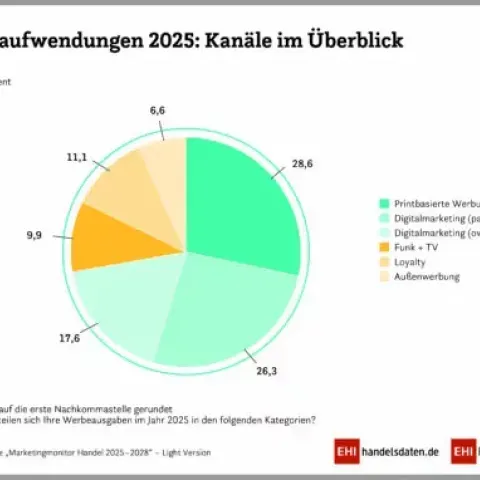
SHERIDAN, WYOMING – October 22, 2025 – As retail advertising continues its digital evolution, German retailers are shifting their budgets decisively away from traditional print and toward data-powered, personalized digital campaigns. According to the new EHI Marketing Monitor 2025–2028, digital channels now capture nearly 44% of total advertising spend — signaling a structural realignment that places data management and artificial intelligence (AI) at the core of retail marketing strategies.
Digital Acceleration Redefines Retail Advertising
Retailers are no longer merely experimenting with online advertising — they are reorganizing their entire marketing architecture around it. The EHI study shows that digital formats, particularly video and app-based promotions, are now key growth drivers. In contrast, printed flyers — once the anchor of weekly retail marketing — continue to decline sharply. Print media now represent only 28.6% of ad budgets, a year-over-year drop of 14.4%.
Meanwhile, investment in digital marketing rose to 43.9% of total spending, up from 38.1% last year. “Data management, process digitalization, and artificial intelligence shape the future of marketing because together they create a foundation for systematically collecting and analyzing large data sets, which can then be used for personalized offers,” explained EHI marketing expert and study author Marlene Lohmann.
Loyalty and TV Advertising Show Diverging Trajectories
The EHI findings also highlight contrasting developments in loyalty marketing and broadcast advertising. Retailers currently allocate 11.1% of their budgets to loyalty programs — a decline of nearly 20% compared to last year’s 13.8%. Analysts attribute this to ongoing investments in data infrastructure that will eventually support more advanced loyalty ecosystems.
Conversely, radio and TV channels have seen renewed interest, growing by 17.9% to capture 9.9% of budgets, while out-of-home (OOH) advertising remains stable at 6.6%. This combination suggests that retailers are complementing digital campaigns with multi-channel awareness formats, reinforcing brand reach across both screen and street.
Data Becomes the New Currency in Marketing
Looking ahead, retailers forecast a continued budget shift toward digital. Paid digital advertising alone is expected to reach 31.4% of total spend — nearly double the share of print, which will fall to 17.6%. The strongest anticipated growth lies in loyalty marketing, projected to rebound by 17.9%, as first-party data and consumer insights become increasingly valuable assets.
In long-term comparison, print advertising has lost 10 percentage points since 2020, while digital formats have gained the same amount — a mirror image of retail’s structural digitalization.
Strategic Implications for the Retail Sector
For retailers, these trends demand new competencies in data governance, automation, and omnichannel communication. The shift from static media to AI-enhanced, analytics-driven advertising models transforms marketing into a predictive, adaptive process — one that measures return on investment (ROI) in real time and leverages consumer data for precision targeting.
Key success factors include:
- Data integration: unifying CRM, POS, and campaign analytics.
- AI-driven personalization: tailoring offers to behavioral and location data.
- Cross-channel orchestration: blending app, video, and OOH campaigns.
- Sustainability alignment: reducing print volume to support ESG goals.
Accessing the EHI Marketing Monitor 2025–2028
The EHI Marketing Monitor 2025–2028 is based on surveys conducted among senior marketing executives from 21 leading German retail companies between June and September 2025. Together, these companies generated €35 billion in revenue and operated approximately 11,000 stores. The full study is available for download from October 22 and is free for EHI members at www.ehi.org.